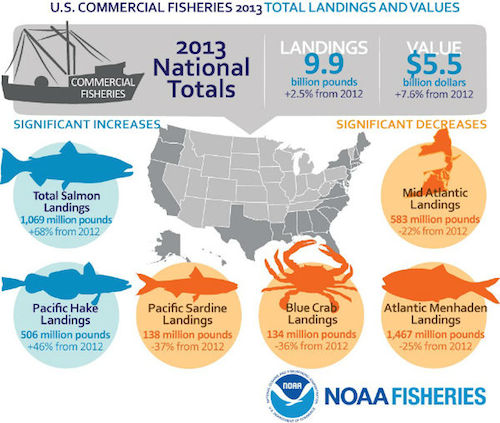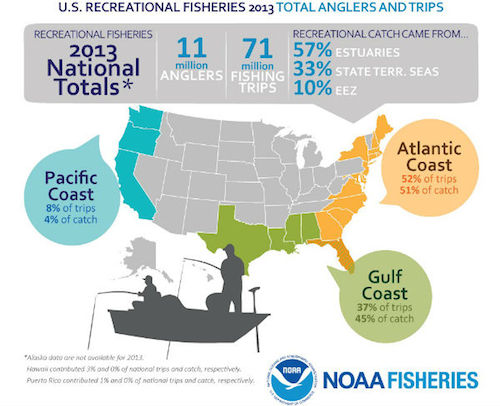Today, NOAA released the 2013 edition of its annual Fisheries of the United States Report, detailing an increase from 2012 in overall landings by volume and by revenue.
WASHINGTON (Saving Seafood) — October 29, 2014 — New England and Alaska remained at the top of U.S. seafood rankings. New Bedford, Massachusetts retains its title as the most valuable port in the nation by revenue, while Dutch Harbor, Alaska is once again the largest port by volume. Elsewhere in the rankings, the commercial menhaden fishery leads along the Gulf and Atlantic coasts, being responsible for 5 of the nation's top 10 ports by volume. In the Western Pacific, which recently made headlines with the establishment of the world's largest marine monument – from which commercial fishing will be prohibited – Honolulu remains the region's most valuable port, and 6th most valuable nationwide.
While the national picture is positive overall, there have been notable declines in some regions and with some species. For example, New England's cod fishery saw one of the most significant declines, with over a 50 percent decrease in both landings and revenue.
Further information, including a press release from NOAA announcing the Report and a link to the full Report, can be found below.
The following was released by NOAA:
In its annual report, Fisheries of the United States 2013, released today, NOAA Fisheries announced that U.S. fishermen landed 9.9 billion pounds of fish and shellfish, an increase of 245 million pounds from 2012. Valued at $5.5 billion, these landings represent an increase of $388 million from 2012.
"Commercial and recreational fishing are important contributors to our economy and help create jobs throughout our nation's communities," said Eileen Sobeck, assistant NOAA administrator for NOAA Fisheries. "Working with our partners, the regional fishery management councils, and the fishing industry, we've made great strides on ending overfishing and are working toward building resilient, healthy and sustainable fish and shellfish stocks."
The report shows that while national total of fish and shellfish landings remained about the same, total landings of wild salmon topped one billion pounds, setting a new record, up 68 percent from 2012. The report also shows that for the 17th consecutive year, the Alaska port of Dutch Harbor led the nation with the highest amount of seafood landed, primarily walleye pollock. Dutch Harbor fishers landed 753 million pounds valued at $197 million.

For the 14th consecutive year, New Bedford, Massachusetts, had the highest valued catch–130 million pounds, valued at $379 million–due mostly to the highly valued sea scallop fishery. Sea scallops accounted for more than 81 percent of the value of New Bedford landings.
Figures for recreational fishing activities remained strong. Nearly 9.5 million recreational saltwater anglers in the United States took more than 71 million marine fishing trips in 2013 and caught more than 430 million fish, of which, 61 percent were released alive.
Spotted seatrout was the top catch for recreational anglers, with 38 million fish caught in 2013. Atlantic croaker, black sea bass, summer flounder and red drum were the other most common catches for saltwater anglers.

Marine aquaculture production in the U.S. has been increasing steadily in recent years, about 10 percent a year from 2008 to 2012, the latest figures available. The top U.S. marine aquaculture species are oysters ($136 million), clams ($99 million), and Atlantic salmon ($77 million).
The report also shows that the average American ate 14.5 pounds of fish and shellfish in 2013, essentially unchanged from 2012.
For more infographics suitable for publication, visit the NOAA home page.
Read NOAA's 2013 Fisheries of the United States Report here
Read a fact sheet summary of the Report here
